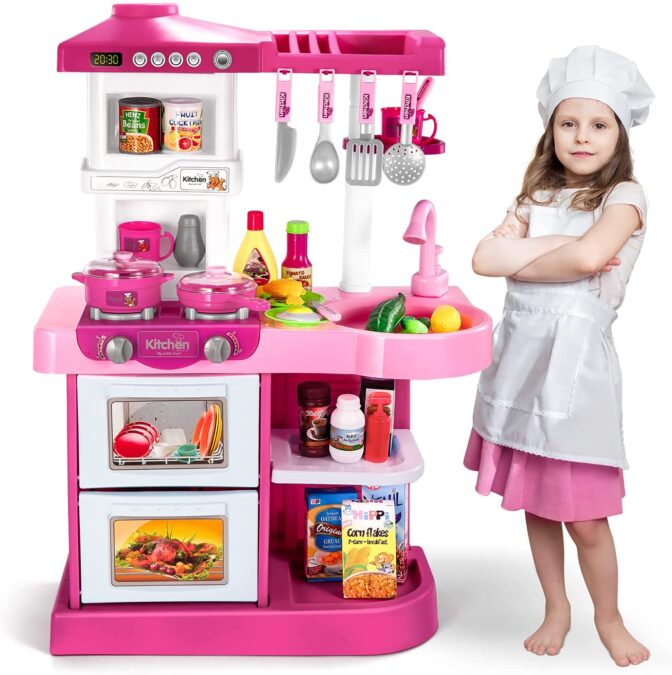Three-year-old Emma watched intently as her mom prepared breakfast one Saturday morning. As the aroma of scrambled eggs and toast filled the kitchen, Emma dashed over to her toy kitchen set in the corner of the room. Mimicking her mother’s every move, she grabbed a plastic egg from the tiny fridge, “cracked” it on her pretend stove, and stirred the imaginary ingredients in a small pan. “Look, Mommy! I’m cooking!” she beamed with pride. What seemed like simple play to her mother was, in fact, much more. Little did Emma’s mom know that this role-playing activity was helping her develop cognitive skills, motor coordination, and social understanding—all key aspects of early childhood development.
Emma’s experience is familiar to many parents and caregivers. Play kitchens are much more than a source of entertainment; they are an essential tool in fostering creativity, enhancing motor skills, and building social-emotional understanding in children. With more and more parents recognizing their developmental value, play kitchens have become a staple in many households and educational settings. In fact, the global market for educational toys, including play kitchens, is projected to reach $34.2 billion by 2026, according to a report by Global Industry Analysts. This article will explore the various benefits of play kitchens, supported by research and statistics while providing insight into the best ways to maximize their potential for young children.
The Developmental Benefits of Play Kitchens
Play kitchens offer a range of developmental benefits that go far beyond mere fun. From improving fine motor skills to fostering creativity and imagination, these mini-kitchens help children learn through hands-on, interactive play. Here’s a closer look at the core developmental advantages that play kitchens provide.
- Boosting Cognitive and Language Development
When children engage in play kitchens, they imitate the actions of adults, such as cooking, cleaning, and serving food. This pretend play is known as symbolic play, which is critical for cognitive development. According to The American Academy of Pediatrics, symbolic play helps children understand the world around them by mimicking real-life scenarios. It enhances their ability to think abstractly, use logic, and develop problem-solving skills.
For instance, when children pretend to cook a meal, they practice sequencing (the order in which tasks should be done), measurement (e.g., understanding the concept of “more” or “less”), and decision-making (what ingredients go together). These activities lay the groundwork for mathematical reasoning and literacy development. According to a study published in Early Childhood Research & Practice, children who engage in pretend play, such as playing with a kitchen set, tend to have stronger language skills and a better grasp of grammar and vocabulary by the time they reach school age.
Play kitchens also provide a platform for language development. When children role-play conversations between chefs and customers or family members preparing meals, they are practising expressive language skills. Asking questions like “Would you like eggs or toast?” or responding with phrases like “Here’s your coffee, sir!” allows them to learn new vocabulary, sentence structures, and conversational turn-taking.
- Enhancing Fine and Gross Motor Skills
A play kitchen is filled with opportunities for children to refine their motor skills. From turning knobs and opening doors to chopping toy vegetables and stirring pretend soup, these actions require hand-eye coordination and precision. Fine motor skills, which involve the small muscles in the hands and fingers, are vital for tasks like writing, buttoning a shirt, and holding utensils.
A 2019 study in Developmental Science highlighted that children who engage in play that involves manipulating small objects—like play kitchens—show significant improvements in fine motor control. Turning the tiny stove knobs, fitting play food into pans, or balancing dishes on a tray helps children develop the talent needed for other essential life skills.
In addition, gross motor skills—movements involving larger muscles—are also honed in a play kitchen. As children move around the space, reaching for items or carrying trays of pretend food, they practice balance, coordination, and spatial awareness. The repetitive motion of these activities helps build strength and control, contributing to overall physical development.
- Fostering Social and Emotional Development
Beyond cognitive and physical growth, play kitchens are crucial for developing social and emotional skills. When children play together, they learn about cooperation, communication, and empathy. For example, they might take turns playing the role of the chef or customer, negotiate who “gets” to cook or serve and learn to express gratitude or compliments for a meal prepared. These interactions help children understand the value of teamwork and shared responsibility.
According to research by Harvard University’s Center on the Developing Child, dramatic play (such as playing house or using a play kitchen) allows children to explore and understand emotions, both their own and others. This kind of play encourages children to express themselves in a safe and controlled environment. They can experiment with different social roles, such as a parent preparing a meal, a waiter taking an order, or a sibling helping in the kitchen, which can improve their emotional regulation and empathy toward others.
Moreover, pretend play allows children to work through real-life experiences or anxieties. For example, a child might use a play kitchen to enact scenarios they’ve witnessed, like preparing a holiday meal or hosting a family gathering. This type of reenactment allows them to process emotions and develop coping mechanisms, making it an excellent tool for emotional growth.
The Evolution of Play Kitchens: Past and Present
Play kitchens have evolved significantly since their inception. In the 1950s and 1960s, simple, gendered kitchen sets targeted mainly at girls were the norm, reflecting societal expectations of the time. However, today’s play kitchens are much more diverse and inclusive, designed to appeal to all children regardless of gender. With the rise of gender-neutral parenting and the recognition that cooking is a life skill for everyone, play kitchens are now marketed as tools for all kids to enjoy.
Modern play kitchens also incorporate more realistic features and are often built with higher-quality materials like wood or sustainable plastic. Many come equipped with lifelike appliances, sound effects, and accessories that mimic real kitchen tools, offering children a more immersive experience. According to the Toy Association’s 2023 Toy Trends Report, sales of realistic, lifelike toys, including play kitchens, have increased by 15% in recent years as parents seek out toys that promote imaginative and experiential learning.
Technology has also entered play kitchens. Some modern sets include interactive features such as sound effects (e.g., sizzling pans and boiling water) and lights that mimic stovetop flames. These innovations make pretend play even more engaging, encouraging longer periods of playtime and helping children maintain their focus.
The Market for Play Kitchens
The rising popularity of play kitchens is reflected in their growing market presence. According to a 2023 report by Statista, the global market for educational toys, which includes play kitchens, was valued at $28.4 billion in 2021 and is expected to grow to $34.2 billion by 2026. This growth is driven by increased demand from parents and educators who recognize the developmental benefits of interactive, role-playing toys.
In the U.S. alone, the educational toy market is projected to grow by 7% annually. As parents continue to prioritize toys that encourage creativity, social interaction, and cognitive development, play kitchens remain a top choice. In fact, data from NPD Group, a global market research firm, shows that play kitchens ranked among the top five most popular types of pretend play toys in 2022.
Tips for Maximizing the Benefits of a Play Kitchen
To fully harness the developmental benefits of a play kitchen, parents and caregivers can take several steps:
- Encourage Open-Ended Play: Avoid giving too many instructions. Let children explore and use their imagination to create their scenarios. This allows for greater creativity and problem-solving.
- Add Realistic Props: While play kitchens often come with plastic food items, adding more realistic props like measuring cups, spoons, and mixing bowls can enhance the play experience and teach real-life skills.
- Play Along: Engage with your child during playtime by taking on different roles, whether it’s a customer at a restaurant or a fellow chef. This interaction not only strengthens your bond but also encourages language development and cooperative play.
- Rotate Accessories: To keep the play kitchen experience fresh and exciting, consider rotating accessories or adding new items such as different food sets, utensils, or even theme-specific items (like holiday meals or baking tools).
Conclusion
From fostering imagination to improving motor skills, play kitchens are much more than toys. They provide a dynamic platform for children to learn, grow, and understand the world around them. As the market for educational toys continues to grow, play kitchens remain a staple for parents and educators seeking to promote cognitive, social, and physical development in a fun, engaging way. Like Emma, whose pretend play mirrored her mother’s real-world actions, children everywhere can benefit from the powerful learning experiences that play kitchens provide.















